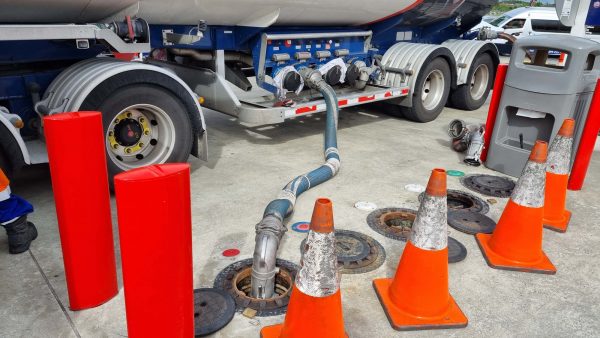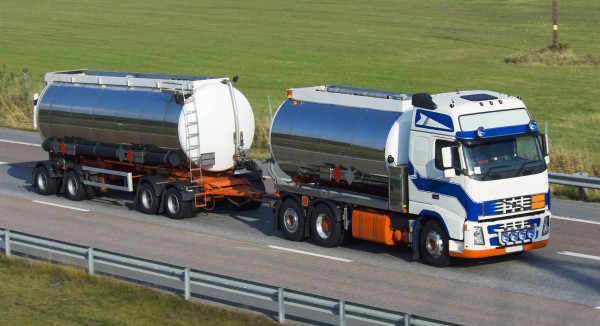A fuel tanker unloads fuel to a petrol station through a process known as fuel delivery. Here’s a general overview of how it typically works:
Journey preparation
The driver checks the journey management plan and ensures that he/she is fit for duty and for the trip ahead. Delivery documentation is collected.
Arrival at the petrol station
The fuel tanker arrives at the designated petrol station at the scheduled delivery time. The driver should get the big picture of the site and unloading area, and look for a suitable location that provides easy access to the petrol station’s underground storage tanks (also called fill boxes). These are accessed by lifting a cover on the forecourt. The driver must be careful of kerbs, planter boxes, bowsers (pumps), and other objects, being aware of the trailer’s swept path when turning.
Positioning the vehicle
Before unloading begins, the driver must verify the delivery address and make any entries into the on-board computer (if applicable). The driver ensures that the lorry is parked securely (park brakes applied, engine off, key removed) and that all safety measures are in place. This may include setting up safety cones or barriers around the truck, doing a hazard assessment check of any potential issues in the area (e.g. naked flames) and ensuring that all necessary equipment, such as hoses and nozzles, are in good working condition. The driver must not block other users from the pumps, where possible.
Safety measures
The driver must not fill to any fill boxes that have lockout tags on them.
The main safety issue when pumping fuel is static electricity as a spark can ignite the fuel. Static electricity can be generated by product flowing in a pipeline, vehicle movement through air, product being pumped and clothing rubbing against the lorry seat or against itself. The driver must ensure that bonding methods are followed, and that the flow rates are within the guidelines for static electricity creation.
The driver then verifies quantities. They may need to do a dip on each tank and ensure that sufficient ullage is available to receive the quantities required in the customer’s tank. These readings are logged on the delivery document. The ‘safe fill’ levels shouldn’t be exceeded.
Connecting to the underground storage tanks
The driver connects the hoses from the fuel tanker to the underground storage tanks at the petrol station. These hoses are equipped with specialised fittings and valves designed to securely attach to the inlet ports of the storage tanks. The driver must know which compartments in the tanker contain what types of fuel – accidentally pumping diesel into a petrol tank is an expensive and time-consuming mistake to fix.

Initiating the unloading process
Once the hoses are securely connected, the driver initiates the unloading process by activating the pump system on the fuel tanker for each compartment. The pump begins to transfer fuel from the tanker’s storage compartments into the underground tanks at the petrol station.
Monitoring the unloading
Throughout the unloading process, the driver closely monitors the fuel flow using the sight glass and ensures it is being transferred safely and efficiently, without leaks. The driver may periodically check the pump system, monitor fuel levels in the storage tanks, and keep an eye on any gauges or indicators on the lorry’s control panel.
If there is not enough room to deliver all the fuel from the tanker, then the driver will deliver only as many full compartments as the tank will hold. If the driver is driving a truck and trailer combination, the trailer fuel is delivered first as this makes for safer driving.

Completion of unloading
Once the desired quantity of fuel has been transferred from the tanker to the petrol station’s storage tanks, the driver stops the pump system, drains the hoses into the customer’s tank and disconnects the hoses from the storage tank inlets. The hoses are carefully drained to ensure that no fuel is spilled during disconnection. If buckets are used to collect excess or drips, these are usually metal so that they are grounded.
The driver then dips the tanks again to verify the delivery is complete and then closes all the fill boxes. If the site is open (i.e. people are filling up with fuel), there may be a discrepancy in the readings.
Safety checks and departure
Before leaving the petrol station, the driver conducts final safety checks to ensure that all equipment is properly stowed and that no fuel spills or leaks have occurred. Spills can be cleaned up using a spill kit; drivers must have spill kit training. Once satisfied that everything is in order, the driver prepares to depart from the petrol station, fills out any documentation and continues with their scheduled route.
Overall, the process of unloading fuel from a tanker to a petrol station involves careful planning, attention to safety, and efficient operation to ensure that fuel is delivered securely and without incident.
